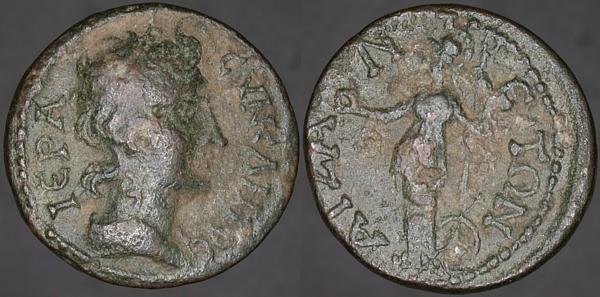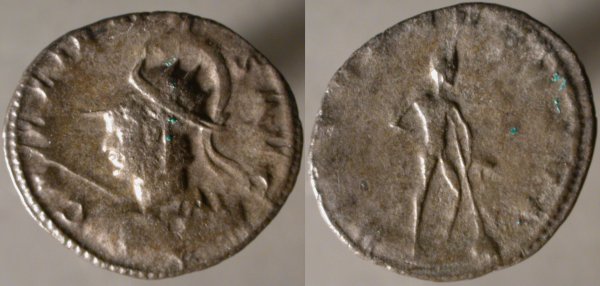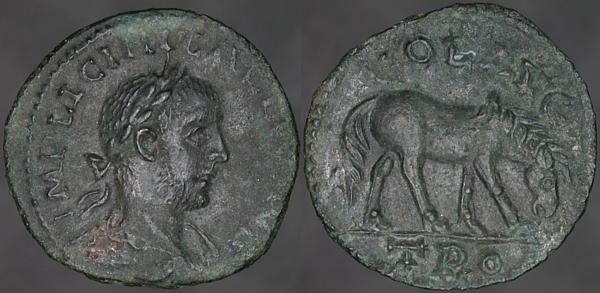Friday, November 10, 2006
Æ28, Aezanis in Phrygia, quasi-autonomous, SNG Copenhagen 67

IEPA CVNKΛHTOC, Youthful head of Synkletos (Senate) right | AIZA_N_EITΩN, Athena standing left, holding phial with right hand, spear with left, shield at feet left.
Putting a date to coins of this city is clearly not settled, both the high-relief type with the bust of Synkletos and those with the lower-relief bust of Boule. I think that the two bust types are probably seperated by at least a century and that the high-relief type is the older, but there's not good documentation to support any of that.
At your own preference, you can choose the most colorful possibility or the least.
Thursday, November 09, 2006
Silvered Æ antoninianus, Gallienus, Mediolanum, Göbl 963u

GALLIENVS AVG, Radiate, helmeted, draped cuirassed bust left, holding spear in right hand and shield in left | VIRTVS AVGVSTI, Hercules standing right, leaning on club right, holding lion-skin right.
I made bids for years on coins with this unusual bust, with a helmet beneath the the radiate crown, before I won one, so I was specially pleased to win this.
While I have at this writing no other example of this reverse from a Western mint, I do have examples from the Asian mints with common busts.
Wednesday, November 08, 2006
Æ Pentanumium, Justin I, uncertain mint, uncertain catalog number

[...], bust right | Chi-Rho, Ε in right field, officina mark "B" in left field
Flavius Iustinus became emperor in 518, 80 years after the death of Valentinian III, years of emperors for whom I have no representative coin. During these years, the Western portion of the Roman empire fell and the Eastern part turned into what we sometimes call the Byzantine, though they certainly thought of themselves as Roman.
Justin is remembered as as a failure as emperor when compare to his nephew and adopted son, Justinian, whom he made emperor in 527, shortly before his own death from disease a few months later.
Tuesday, November 07, 2006
Æ21, Alexandria Troas, Gallienus, SNG von Aulock 1486

IMP LICINI GALLIEN[VS], Laureate draped bust right | COL AVG TRO, Horse grazing right.
The coins of Alexandria Troas are a good place to begin collecting Provincials since the inscriptions are Latin not Greek, so are easier to read, they're often seen with relatively common reverse designs like this grazing horse (with less common scenes also available) and their small-to-medium size means they're often modestly-priced.
Coins of this city are also well-documented in Alfred R. Bellinger's Troy the Coins which includes some of the author's speculation, and learning to spot that, and to dispute it, will be a valuable skill as you learn about Provincials.
Monday, November 06, 2006
Billon antoninianus, Gallienus, Rome, Göbl 1t

IMP C P LIC GALLIENVS AVG, Radiate draped cuirassed bust right | P M TR P II COS P P, Virtus standing left holding shield resting on ground with right hand and grounded spear with left.
A recent acquisition, this is dated to the months that the date-specific part of the reverse legend (TR P II COS) was true: January to September, 254. This coin is part of the first coin listed in Göbl's catalog, which orders dated coins before undated, a conventional sequencing seen in many other catalogs.

